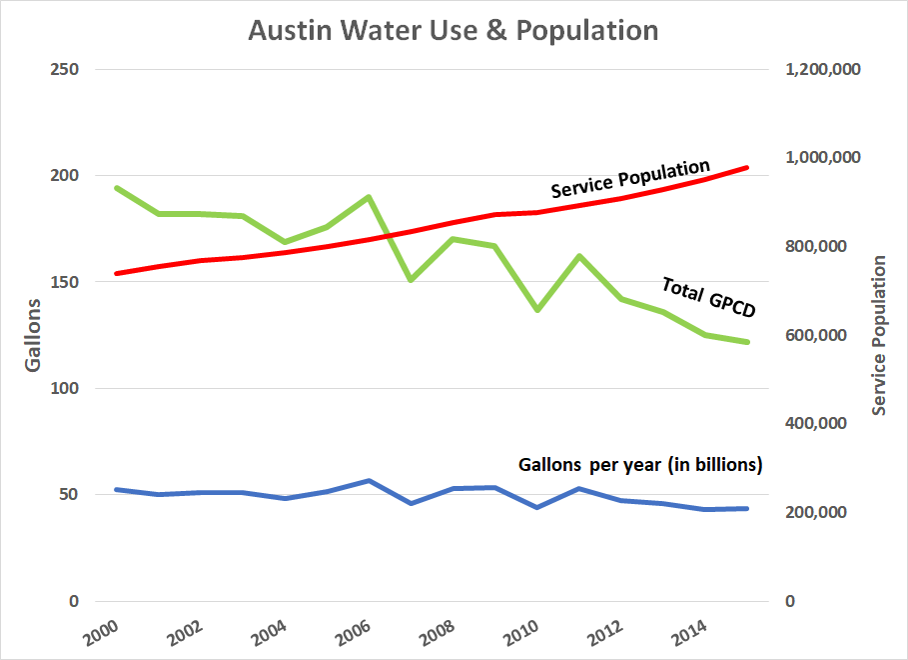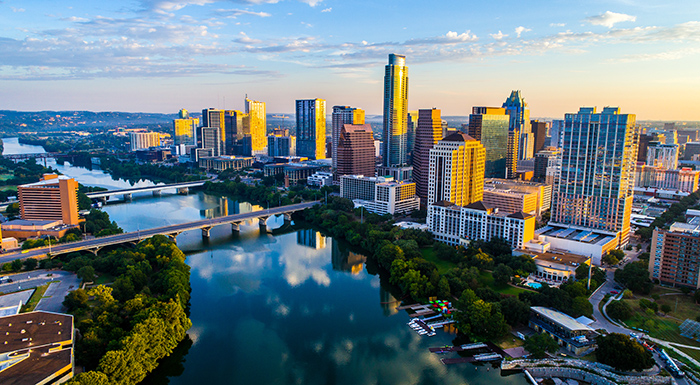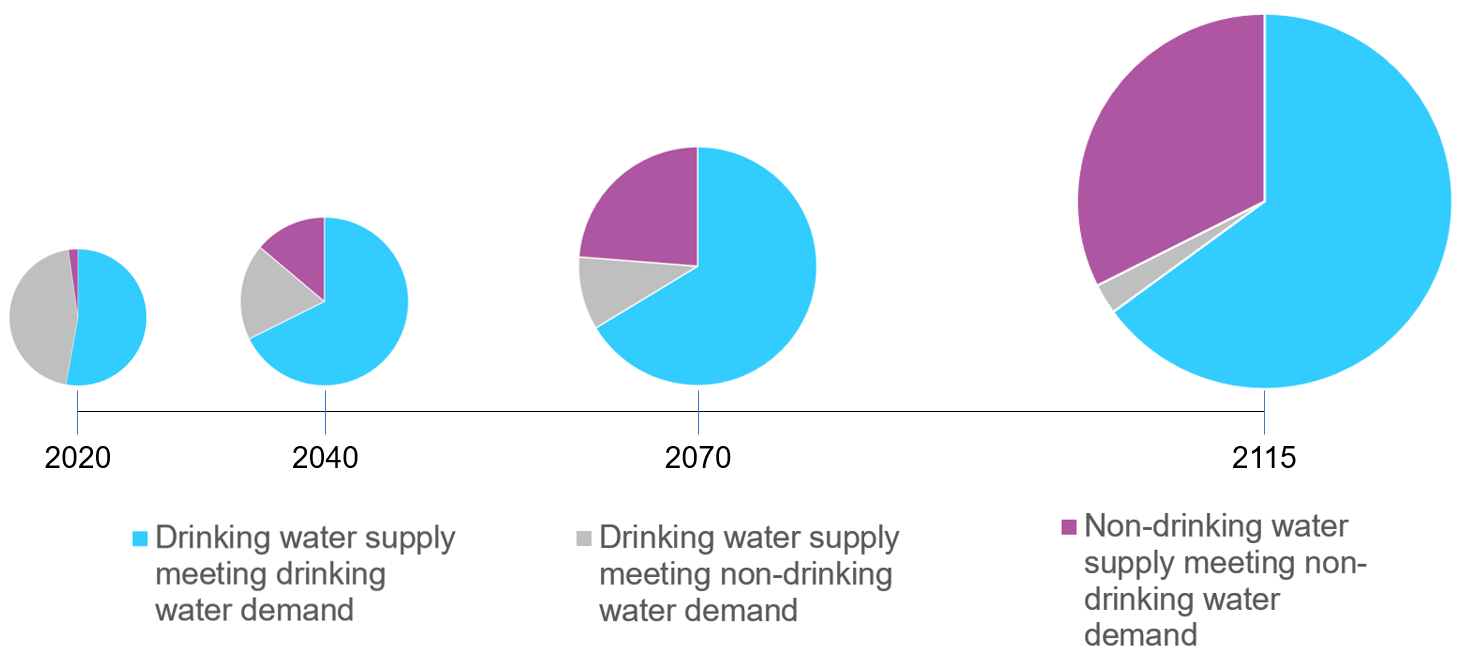A Water Plan for the 22nd Century
Image: Austin skyline with the Colorado River of Texas running through it. Photo credit: City of Austin
I’ve just read Austin’s new 100-year water plan. Never seen anything like it.
Most water plans for US cities now include some degree of “demand management” (aka water conservation) — instead of focusing only on strategies for bolstering their water supplies to serve their growing populations. Some cities have learned how to structure their tiered water pricing in ways that discourage waste while not making water unaffordable for their poorest residents. Some have begun to reuse their treated wastewater, and some are now entertaining the idea of capturing urban stormwater to enhance their water supplies. A few have begun to seriously consider climate change in their long-range water planning
Austin Water’s new “Water Forward” plan does all of this in spades. And it does a whole lot more.
The Water Forward plan is a response to both the historic 2008-2016 drought and the challenge of supplying water to one of America’s fastest-growing urban populations. During the drought the reservoirs that supply Austin’s drinking water fell to dangerously low levels. Carlos’n Charlie’s, a raucous bar on Lake Travis that served as a favored weekend habitat for Austin’s scantily clad and sunburnt party animals, closed in 2013 as the lake shriveled and stranded the bar’s wharf.
In 2014, with drought’s end nowhere in sight, the Austin City Council reached out to its citizens for help. “The council convened a citizen task force, and their primary recommendation was to develop a new integrated water resource plan,” recalls Marisa Flores-Gonzalez, who was hired by Austin Water to manage the development of that plan. “We were fortunate to have some great examples to learn from. Our neighbor San Antonio has done a wonderful job of diversifying its water supplies and integrating demand management into their portfolio. For guidance on onsite reuse, we looked to San Francisco Public Utilities Commission; they’re leaders in integrating centralized and decentralized reuse. To gain insights into what ‘integrated water planning’ really means we looked to Los Angeles and their planning efforts.”
Typical of urban water plans drawn for US cities, Austin’s Water Forward plan focuses on strategies to better survive another drought of record — but then goes two big steps beyond. Recognizing that climate change is not a hoax, the water planners anticipate a drought considerably worse than the historical drought of record. And instead of looking 50 years ahead as other urban plans do, Water Forward looks all the way out to 2115.
The result is an ambitious blending of hyper-aggressive water conservation and innovative development of “alternative” water supplies such as water reuse and stormwater capture. Austin’s admirable water conservation initiatives already provide a smart, cost-effective response to their explosive (~3% per annum) population growth. Austin Water does free water audits for its residents and businesses and has paid its customers to install water-efficient toilets, shower heads, washing machines, soil moisture meters, smart irrigation controllers, and water-appropriate landscaping. The utility has also scoured its entire water distribution system to detect and repair leaks.
These investments in demand management lowered Austin’s per-capita daily water use by 37% from 2000-2015, enabling the city to use 17% less water while its population grew by one-third. Water Forward builds on this momentum: the plan’s demand-management strategies are designed to lower total per-capita daily water use from today’s 126 gallons to 93 gallons by 2115.

Image: Austin’s aggressive water conservation programs have enabled the city’s residents to cut their daily water use by 37% and the city’s total water use by 17% even while its population grew by one-third during 2000-2015. Data source: Austin Water
The plan also includes strategies to make use of ALL available water, including rainwater, stormwater, graywater, air conditioning condensate, and wastewater (typically called “alternative waters”) that can be treated and reused to meet non-drinking water demands such as landscape irrigation. How many cities do you know that intend to capture the condensate from its air conditioning systems as part of its water supply?!
To secure these alternative water supplies, the plan recommends immediately developing ordinances to require that new commercial and multifamily buildings install dual plumbing and use alternative water generated on-site or from the city’s reclaimed water system for both indoor and outdoor non-drinking water purposes. It is this deep integration of centralized and decentralized strategies that Flores-Gonzalez sees as a distinguishing feature of the Water Forward plan. The figure below shows how, over time, Austin plans to phase out the use of potable drinking water supplies for non-drinking water purposes.
Image: Over the coming 100 years, Austin plans to phase out the use of high-quality drinking water for landscape irrigation, toilet flushing, and other non-potable purposes and instead use “alternative sources”. Source: Water Forward – A Water Plan for the Next 100 Years. Austin Water, 2019
Perhaps the most impressive aspect of this planning process is that fact that Austin Water understood that their plan would never be successfully implemented without strong backing from both city government and the community, and this understanding strongly influenced the way in which they built the plan. “To reach our ambitious 2040 goals, we need to get started now” says Flores-Gonzalez. “With anything new, starting is always the most difficult part. There needed to be a lot of internal knowledge-building. But I feel like we’ve jumped into it head first and we’re ready and roaring to go. We have teams that are really excited about these strategies and they see the potential of this plan. They’re excited to do something really great for our community. It’s so important for us to make sure we’re working collaboratively, not only with staff within all city departments but also with our citizen task force and with our community members. There’s definitely going to be challenges, but I feel we’ve put in a lot of time and effort to build strong relationships, and it really boils down to whether you have their trust and the quality of relationships that will get you through the rough spots.”
After three years of intense work and more than 80 public outreach events, Austin now has a plan to win the race with climate change. At least for the next 100 years.
Brian
p.s. If you’re proud of your own city’s water plan and want to tell me about it, please drop me a note!


